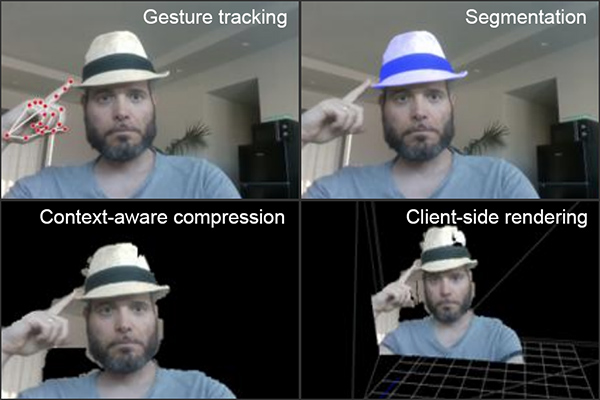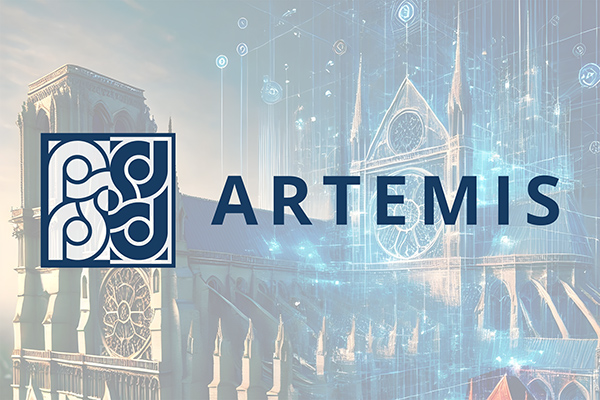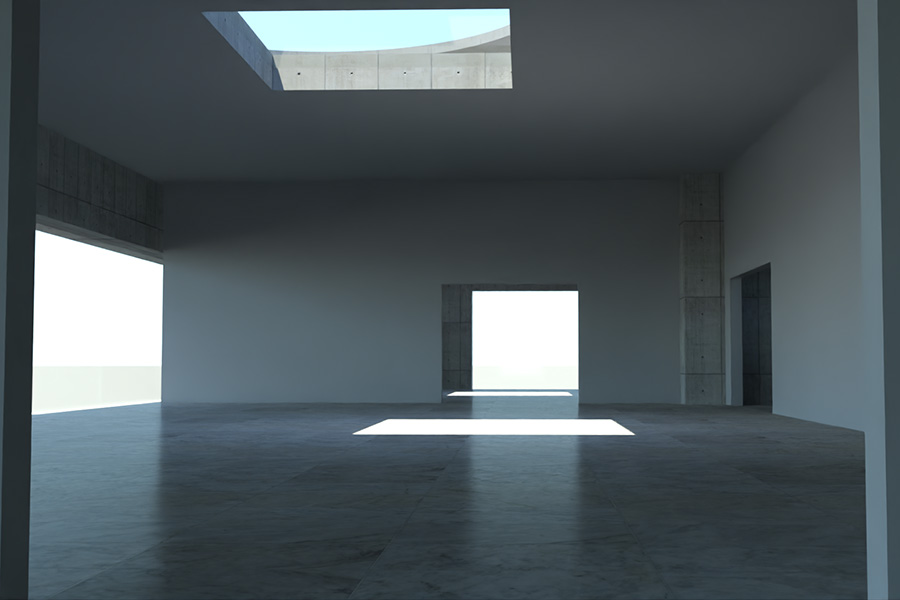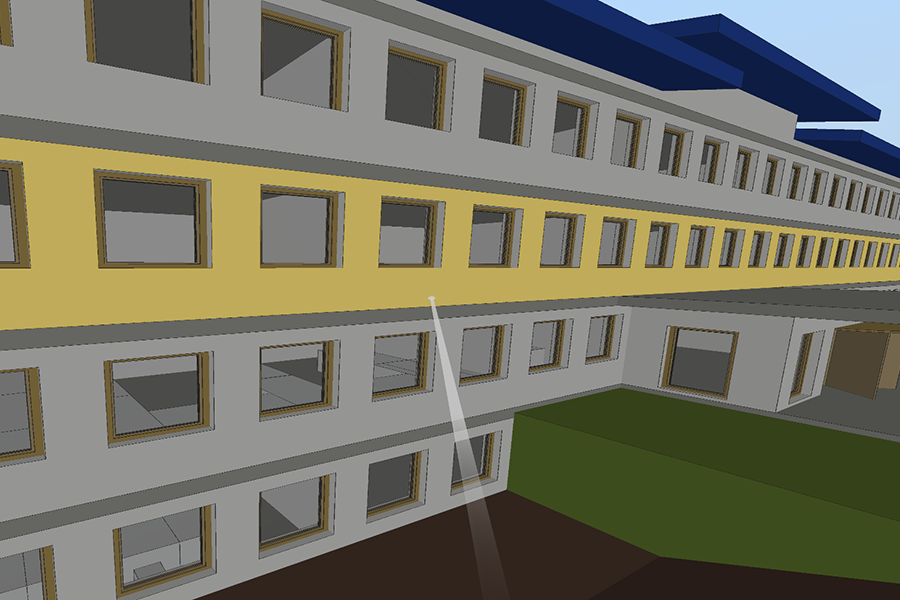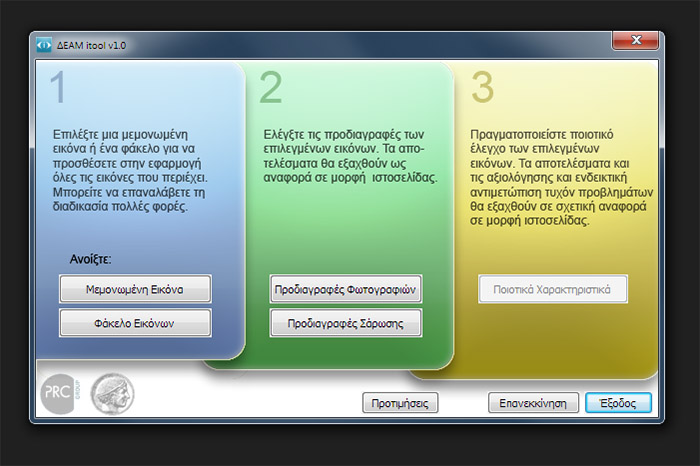Technical and Research Projects
This page contains brief information about projects undertaken by members of the Computer Graphics Group or the group as a research team. The list is sorted in chronological order.
-
HOPE - Holographic Optimized Processing Engine
2025, SPIRIT-XR (2st Open Call), Horizon Europe.The HOPE project enhances the SPIRIT platform by advancing real-time holographic communication for retail applications, with a specific focus on real-time teleconference experiences. The project will focus on incorporating semantic, importance-driven compression, resampling, and filtering to highlight essential details, such as facial features, body movements and even points of interest. This not only optimizes bandwidth usage but also improves the overall user experience by delivering high-quality visualizations even in bandwidth-constrained environments.
Group member roles:
- G. Papaioannou: AUEB Principal Investigator
- I. Evangelou: senior researcher / developer
- Vasileios - Ektor Kotsis - Panakakis: junior researcher / developer
-
ARTEMIS - Applying Reactive Twins to Enhance Monument Information Systems
2025-2027, HORIZON-INFRA-2024-TECH-01-04, Project No. 101188009.ARTEMIS aims to create a digital infrastructure to support the conservation and restoration of cultural heritage while leveraging the potential of 3D visualization technologies. The project is based on the innovative concept of the “Reactive Heritage Digital Twin”, a digital replica of real objects that will have a decisive impact on European Research Infrastructures.
ARTEMIS will integrate data management, providing researchers and professionals with access to a vast repository of over four million scientific and technical reports, alongside advanced visualization and simulation techniques. This will enable virtual restoration experiments, allowing experts to test restoration strategies without physically altering heritage assets. While the project primarily targets the scientific and professional community, its ability to simulate and visualize restoration outcomes will also be invaluable for decision-makers to evaluate restoration strategies in advance. Ultimately, the general public will benefit from cost reductions and enhanced heritage preservation, ensuring the transmission of cultural treasures to future generations.
The project brings together 22 partners from 12 EU countries, along with two major restoration centres as affiliates. ARTEMIS is led by CNR-INO, an institute of the Italian National Research Council working on optical heritage diagnostics since more than 40 years.
Group member roles:
- G. Papaioannou: AUEB Principal Investigator
- I. Evangelou: senior researcher / developer
- Vasileios - Ektor Kotsis - Panakakis: junior researcher / developer
-
LOTUS - Light OptimizaTion for Urban Spaces
2022-2024, Hellenic Foundation for Research and Innovation.The LOTUS project aims to investigate and develop goal-driven computational lighting design methods for large-scale constructions and environments, which can be directly applicable to architectural and civil engineering design cycles in order to improve energy efficiency, lighting quality and ease the design lifecycle itself. The focus of the research is on large scale luminaire placement and automatic opening designthat exploits both natural and artificial lighting.
Group member roles:
- A. Gkaravelis: Principal Investigator
- N. Vitsas: researcher / developer
- I. Evangelou: researcher / developer
- G. Papaioannou: advisor
-
High-fidelity VR Cluster for the Tholos Dome Theater
2022-2023, Foundation of the Hellenic World.Setup, installation and development of an VR cluster solution for the multi-headed interactive dome theater "THOLOS" of the Foundation of the Hellenic World.
Group member roles:
- G. Papaioannou: Principal Investigator
- A. A. Vasilakis: lead researcher / developer
- A. Gkaravelis: researcher / developer
-
Virtual Sculpting
2021-2022, Foundation of the Hellenic World.Development of a VR application for untethered devices for interactive sculpting using realistic tools. The project involves the development of specialized techniques for simulation and rendering of the sculpting process in low-end devices, at high frame rates.
Group member roles:
- G. Papaioannou: Principal Investigator
- A. Gkaravelis: Researcher / lead developer
- I. Evangelou: Researcher / developer
-
Building Information Model VR plugin for the CostOS software
2021-2022, Nomitech Ltd.Development of a VR renderer module for the previewing and inspection of BIM 3D models.
Group member roles:
- G. Papaioannou: Principal Investigator
- A. Gkaravelis: Researcher / developer
- N. Vitsas: Researcher / developer
-
EPIC MegaGrants – Rayground
2021, Epic Games Inc.The Epic MegaGrants program encourages projects that will benefit the Unreal Engine ecosystem or the 3D graphics community. Rayground is an online framework for rapid prototyping of algorithms based on the ray tracing paradigm. Rayground is platfrom-independent, based on open-source technologies and available to everyone through the www.rayground.com portal. We identify two distinct components in Rayground. The first component is the website, which acts as an online library of ray tracing projects and offers an integrated development environment (IDE) for interactive demonstration and/or prototyping. It has the potential to function as a hub for the graphics community as ray tracing ideas and methods become more widespread. The second component is WebRays, the ray tracing engine that accelerates ray-geometry intersections using the WebGL2 graphics application programming interface (API). The core technology behind the engine is decoupled from Rayground’s programming model and utilizes an open-source general-purpose ray-geometry intersection engine on the Web via a JavaScript API, backed by acceleration data structures.
WebRays github page: https://cgaueb.github.io/publications/webrays/
Group member roles:
- G. Papaioannou: Principal Investigator
- A. A. Vasilakis: Senior researcher / developer
- A. Gkaravelis: Senior researcher / senior developer
- N. Vitsas: Researcher / senior developer
-
IFC Model Geometry Validation
2021, Nomitech LTD.During this small project, functionality was developed for the geometric validation of Building Information Model elements, including robust inter-penetration testing and element automatic labeling (see also our paper: I. Evangelou, N. Vitsas, G. Papaioannou, M. Georgioudakis, A. Chatzisymeon, Shape Classification of Building Information Models using Neural Networks, proc. Eurographics Workshop on 3D Object Retrieval, 2021).
Group member roles:
- G. Papaioannou: Principal Investigator
- N. Vitsas: Researcher / developer
- I. Evangelou: Researcher / developer
-
Tales from Block 15 – A Virtual Journey to a Grim Past
German Federal Foreign Office (German-Greek Future Fund), 2020-2024, Project No. EP-3279-01."Block 15: a virtual journey " is an R&D project hosted by the Department of Informatics, Athens Univesity of Economics and Business, focusing on the infamous Block 15 of the Haidari Concentration Camp in Western Athens, the largest and most notorious German concentration camp in wartime Greece. The project, so far the first and only of its kind in Greece and SE Europe, makes the building, currently an endangered one, accessible to audiences and communities of diverse backgrounds through the use of immersive technologies. The project was co-funded by the German Federal Foreign Office through funds of the Greek-German Future Fund and the Hellenic Ministry of Culture.
Through an original interactive scenario based on primary and multimedia archival sources and with the employment of digital storytelling, the immersive Virtual Reality experience not only brings back to life the actual monument that is Block 15, but also functions as a reminder of the horrors and torture inflicted by the Nazis on prisoners, in an attempt to reintroduce a historically and politically contested site to heterogeneous audiences. "Block 15" was supported by the Municipality of Haidari, the Central Board of Jewish Communities in Greece (KIS) and the Jewish Community of Athens.
The final VR production, running on Meta Quest 2 VR headsets, is free to download and install on compatible devices and is translated to English, for non-Greek users.
Group member roles:
- G. Papaioannou: Technical supervisor
-
Lumibricks: Modular Light Transport for Photorealistic Rendering on Consumer-grade GPUs
EPAnEK -Operational Programme Competitiveness, Entrepreneurship and Innovation (proj. No. 5049904), 2020-2021.
Group member roles:
- G. Papaioannou: Principal investigator
- K. Vardis: Senior researcher/developer
- A. A. Vasilakis: Senior researcher/developer
-
Proof-of-concept Implementation of Coarse Shading Technologies for the ARM MALI-G76 BIFROST Architecture
HUAWEI TECHNOLOGIES OY CO. LTD, 2019, Project No. EP-3159-01
Group member roles:
- G. Papaioannou: Principal investigator
- K. Vardis: Senior researcher/developer
- A. A. Vasilakis: Senior researcher/developer
-
Physically-based Lighting Simulation and Optimization Algorithms, PhD Fellowship Grant
This 2-year fellowship (2017-2019) funded by the Hellenic Foundation for Research and Innovation (grant No. 1545), supports the research of doctoral candidate Nick Vitsas in the domain of illumination-driven scene optimization, including topics such as opening design, luminaire placement and scene arrangement.
Group member roles:
- G. Papaioannou: Principal investigator
- N. Vitsas: Researcher
-
Visualization Engine for the CostOS software by Nomitech Ltd.
The AUEB Computer Graphics Group has established a collaboration with Nomitech Ltd (2016-2019). for the design and development of real-time visualization solutions for large-volume 3D datasets. Nomitech Ltd. is a leading niche software company specializing in cost estimating solutions for construction, mining, oil, gas and energy projects.
Group member roles:
- G. Papaioannou: Engine architecture design
- K. Vardis: Senior Researcher, developer
- A. Gkaravelis: Researcher, developer
-
GLIDE - Goal-driven Lighting for Dynamic 3D Environments (ARISTEIA II programme),
18-month research project co-funded by the General Secreteriat of Research and Technology and the European Union, 2014-2015.
Group member roles:
- G. Papaioannou: Principal investigator
- A. Vasilakis, Post-doctoral researcher
- A. Andreadis: Researcher, developer
- K. Vardis: Researcher, developer
- A. Gkaravelis: Researcher, developer
- C. Kalampokis: Researcher, developer
-
PRESIOUS - Predictive digitization, restoration and degradation assessment of cultural heritage objects
3-year EU-funded STREP project (grant no. 600533), 2013-2016.
Group member roles:
- G. Papaioannou: Principal investigator (AUEB), Systems Architect
- P. Mavridis: Senior Researcher, Developer
- A. Andreadis: Researcher, Developer
- K. Vardis: Researcher, lead developer
- M. L. Menexi: Developer
- G. Tsatiris: Junior Researcher
-
Real-time Global Illumination Algorithms
One-year university-funded research project, Athens University of Economics and Business Special Account for Research Grants (ΕΡ-1805-33/ 00-1), 2011-2012.
Group member roles:
- G. Papaioannou: Principal investigator.
- A. Gaitatzes: Graduate Researcher
- P. Mavridis: Graduate Researcher.
-
Realistic Environment Illumination for Real-time Graphics
One-year university-funded research project, Athens University of Economics and Business Special Account for Research Grants, 2009-2010.
Group member roles:
- G. Papaioannou: Principal investigator.
- M. L. Menexi: Graduate Researcher
- C. Papadopoulos: Undergraduate Researcher.
-
Digitization of the Greek Ministry of Culture Monument Collection
Greek Ministry of Culture development project. Contractor: PRC Group – Forth, Sub-contractor: Athens University of Economics and Business, 2008-2009.
Group member roles:
- G. Papaioannou: Training Coordinator, Scientific Coordinator of Digitization, software development.
- M. L. Menexi: Instructor (digitization).
-
The Battle of Chaeronia
Virtual Reality Installation, Independent production, 2007-2008.
Group member roles:
- A. Gaitatzes: Coordinator, integrator
- G. Papaioannou: Software engineer
-
THOLOS
Design and Construction of a 132-seat Virtual Reality Dome Theatre, Foundation of the Hellenic World, 2002-2006.
Group member roles:
- A. Gaitatzes: VR team coordinator, software engineering (VR computer cluster architecture) and integration
- G. Papaioannou: Software engineering (VR computer cluster architecture, dynamic multi-projection display subsystem and THX positional audio system)


